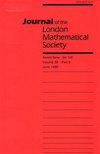立方 L $L$ 函数极值在 s = 1 $s=1$ 时的非对称分布
IF 1
2区 数学
Q1 MATHEMATICS
Journal of the London Mathematical Society-Second Series
Pub Date : 2024-09-24
DOI:10.1112/jlms.12996
引用次数: 0
摘要
我们研究了 s = 1 $s=1$ 时立方迪里夏特 L $L$ 函数值的分布。按照 Granville 和 Soundararajan 对二次 L $L$ - 函数的想法,我们通过附在每个素数上的特定随机变量 X ( p ) $\mathbb {X}(p)$ 的随机欧拉积 L ( 1 , X ) $L(1,\mathbb {X})$ 的分布来模拟 L ( 1 , χ ) $L(1,\chi)$ 的分布。我们得到了关于 | L ( 1 , χ ) | $|L(1,\chi)|$ 大于或小于给定边界的比例的描述,并为利特尔伍德边界提供更多启示。与二次情况不同,三次情况的下限和上限不对称,小值比大值更不可能出现。本文章由计算机程序翻译,如有差异,请以英文原文为准。

Asymmetric distribution of extreme values of cubic
L
$L$
-functions at
s
=
1
$s=1$
We investigate the distribution of values of cubic Dirichlet -functions at . Following ideas of Granville and Soundararajan for quadratic -functions, we model the distribution of by the distribution of random Euler products for certain family of random variables attached to each prime. We obtain a description of the proportion of that is larger or that is smaller than a given bound, and yield more light into the Littlewood bounds. Unlike the quadratic case, there is an asymmetry between lower and upper bounds for the cubic case, and small values are less probable than large values.
求助全文
通过发布文献求助,成功后即可免费获取论文全文。
去求助
来源期刊
CiteScore
1.90
自引率
0.00%
发文量
186
审稿时长
6-12 weeks
期刊介绍:
The Journal of the London Mathematical Society has been publishing leading research in a broad range of mathematical subject areas since 1926. The Journal welcomes papers on subjects of general interest that represent a significant advance in mathematical knowledge, as well as submissions that are deemed to stimulate new interest and research activity.

 求助内容:
求助内容: 应助结果提醒方式:
应助结果提醒方式:


